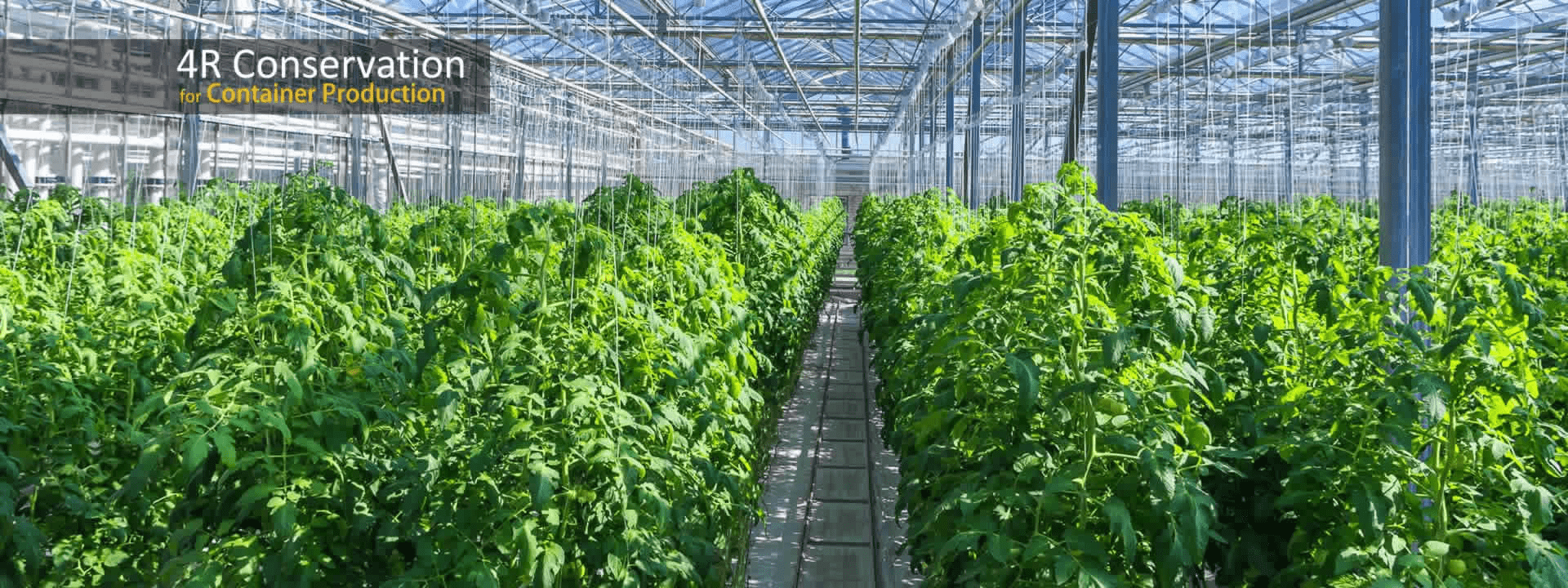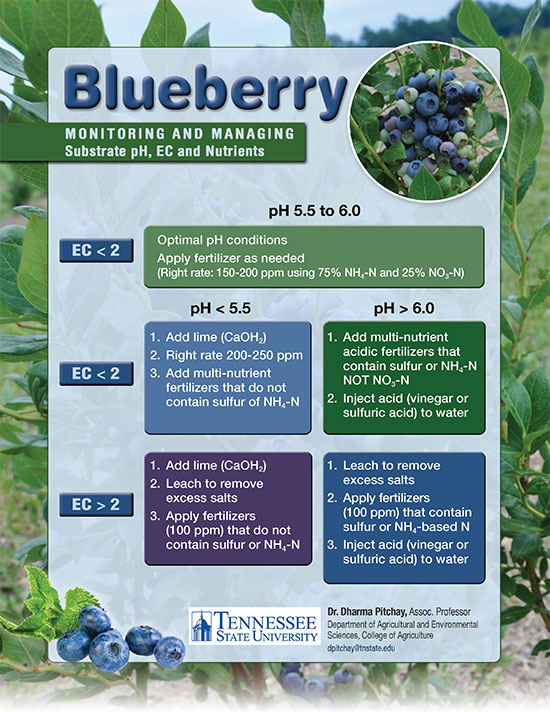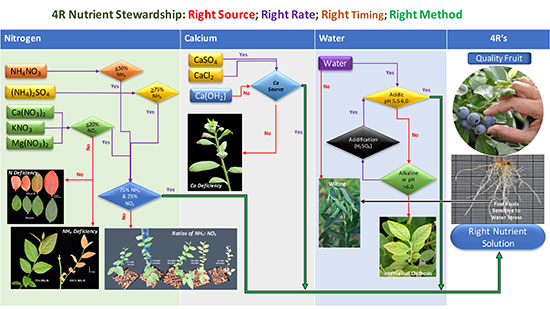- Home >
- 4rconservation
- > Blueberries
Blueberries
Popular Plant with Consumers and Planters
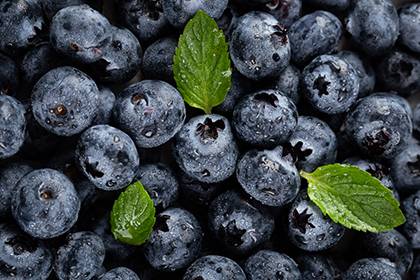
Blueberry plants are grown for their nutritious berries, landscaping purposes, and to provide an environment for birds. Because blueberries are loaded with antioxidants and phytonutrients, they are in high demand by both consumers and producers alike. These plants are easy to grow, as long as the soil in which they are to be grown is acidic. In the fall, their foliage turns crimson red or yellow. They are the perfect plants for the home garden.
 Growing Tip: Blueberries are in high demand thanks to their abundance of super nutritious antioxidants and phytonutrients.
Growing Tip: Blueberries are in high demand thanks to their abundance of super nutritious antioxidants and phytonutrients.
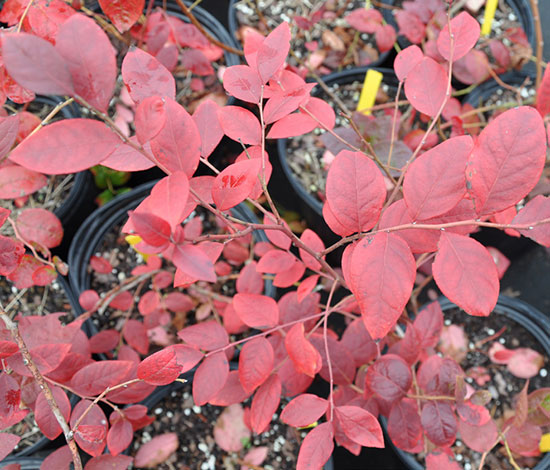
Blueberry leaves may turn a beautiful crimson red during the fall season.
What do I need to grow blueberries?
Blueberries require well-drained, acidic soil that is high in organic matter. The soil may be supplemented with peat or pine bark. After selecting and planting healthy plants, cover the soil surface with organic mulch or landscape fabric covered with pine bark or straw. Stake, water (as needed) and nourish the plants with an acid-forming fertilizer such as ammonium sulfate for conventional farming or granulated sulfur for organic farming.
Selecting blueberry plants
Most local nurseries and box stores such as Home Depot, Lowe's and Wal-Mart sell young plants during the fall/spring. Select healthy, vigorous plants of at least two years old that are free of diseases and pests to ensure a better success rate. The root system should be firm with white root tips and not root-bound. Healthy plants will produce early fruiting and more berries.
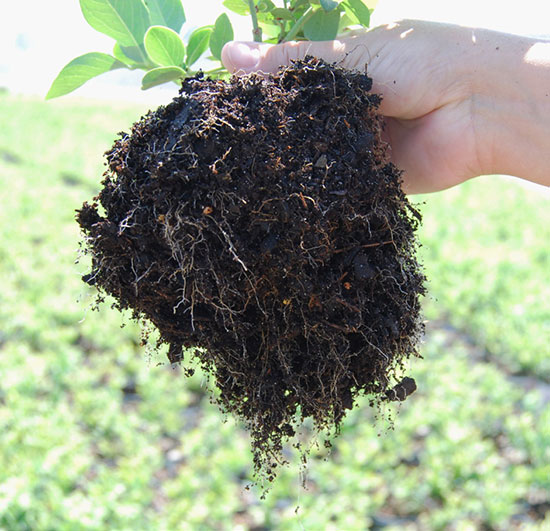
A root ball with fine, white tips indicates a healthy plant.
 Growing Tip: Healthy plants produce more berries.
Growing Tip: Healthy plants produce more berries.
Preparing the planting site
Unlike most plants, blueberry prefers an acidic soil similar to that of Azalea and Rhododendron. The optimum pH value is 5.0 to 6.0 (acidic). The addition of peat and pine bark will acidify the root environment and improve aeration and drainage. In heavy clay soils, add 1-part sand, 2-parts pine bark or peat moss, and 1-part good top soil. In loamy soils, omit the sand. In silty or sandy soils, add 1 additional part of peat. The addition of granular sulfur at a rate of 0.5, 1.5, and 2.5 teaspoons per planting hole for sandy, loam, and clay soils, respectively, will lower the pH.
 Growing Tip: The optimum pH value for blueberry soil is 5.0 to 6.0 (acidic).
Growing Tip: The optimum pH value for blueberry soil is 5.0 to 6.0 (acidic).
What makes a suitable site?
Blueberry plants are sensitive to frost damage. Therefore, avoid planting in low-lying areas. Other factors to consider include: a) soil drainage (do not plant in a flood-prone or water-stagnant area); b) good aeration; and c) acidic soil high in organic matter.
Preparing the planting ground
Plant blueberries during late fall or early spring. In poorly drained soils, plant them in raised beds to avoid any water-logging. The height of the bed depends on the water table at that particular site. If the water table is high as shown in Figure D below, the bed height should be above the level of the water table. It is not necessary to make raised beds in areas with a low water table (Figure A). Regular watering is more critical in areas with a low water table (Figure A) than in those with a high water table (Figures C and D).
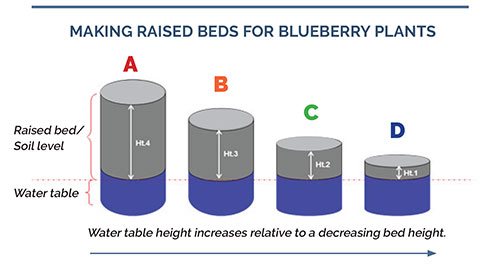
Does raised bed height matter?
The availability of water depends on the water table, raised bed height, and planting hole depth. The availability of water declines with increased planting bed height. Less water is available in raised bed A. The high water table in bed D creates excessive water availability and water-logged conditions, which limit plant growth. Appropriate bed height (B and C) is critical for healthy plant growth.
Initial planting depth is crucial for providing the proper amount of water and air for plant growth and development. Deep planting (Figure A below) may result in a water-logging and poor aeration, which can ultimately lead to plant death. Planting moderately deep (Figure B below) can result in poor root development and delay the overall growth and development of the plant. The best depth of planting (Figure C below) provides optimal conditions for vigorous plant growth.
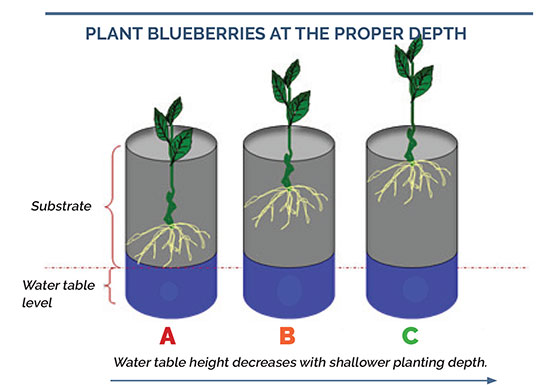
Does planting depth matter?
It is essential to plant blueberries at the proper depth. The plant in Figure A is prone to water-logging and the plant in Figure B is prone to poor root development; the plant in Figure C shows the proper planting depth to give the plant its best chance to succeed.
Plants should be spaced with 3-to-4 feet between them, and with 5-to-6 feet between rows. The size of the planting hole depends on root ball size. For a two-year-old plant, a 12" by 12" width and 14" depth is recommended.
Transplanting a container-grown blueberry plant
Be sure to water plants within a few hours of transplanting (while they are still in their containers). Remove weak or dead branches, keeping only 3 or 4 strong ones. Then, remove the plant from the container and score/scratch the surface of the root ball to induce easy proliferation of new roots. Before placing the seedling in the planting hole, fill 1/3 of the hole with the prepared substrate mix. Then place the seedling in an upright position and cover the root ball with the remaining substrate. Avoid planting too deep or at intermediate depth (Figures A and B above) to avoid water-logging and protect against unexpected increases in the water table.
 Growing Tip: Avoid planting too deep to protect against water-logging and unexpected increases in the water table.
Growing Tip: Avoid planting too deep to protect against water-logging and unexpected increases in the water table.
Steps to follow after planting
1. WATERING
In most instances when plants fail to grow, it is due to poor water management. This includes overwatering and underwatering. Plants obtain their essential nutrients for growth through water. Dissolved nutrients in water are mobilized for uptake by plants. Anywhere from 60-to-95 percent of fresh plant weight comes from water. When there is too much water (water-logging), the air is pushed out of the soil and the root system dies. Therefore, it is critical to provide the right amount of water at all times.
➢ Remember to water plants thoroughly immediately after planting. Water lightly (using a water breaker or watering can) by making several rounds until the substrate is fully saturated. This prevents the substrate from collapsing and maintains its physical properties. It is necessary to provide water before the soil dries out during establishment.
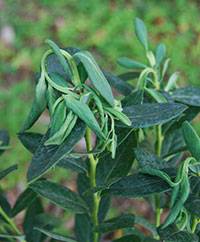
|
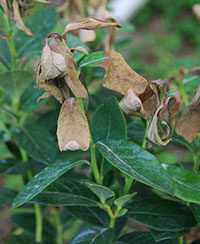
|
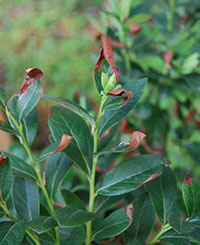
|
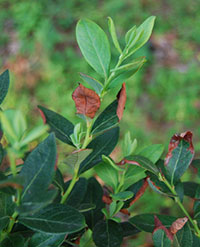
|
Signs of water stress symptoms as a result of not providing enough water: A) (top left) The first sign to appear is wilting of young shoots; B) (top right) By day 4, the wilted leaves turn gray; C) (bottom left) Gray leaves turned brown on day 7, and new young shoots begin to grow after watering; D) (bottom right) Recovery (growth of multiple young shoots) after water stress takes about 15 days.
2. STAKING
If branches are weak, stake the plants to provide support and a good open canopy for air movement.
3. MULCHING
Cover the soil surface around the plant with a thick organic mulch or landscape fabric covered with pine bark or straw. This will create an optimal root zone environment for root growth by providing protection against frost and weed growth, and it will help to retain soil moisture.
What about fertilizer?
Blueberries are LIGHT feeders. Therefore, too much fertilizer can slow down the plants' growth. Apply water-soluble acidic fertilizers such as those used for Azalea and Rhododendron (20:10:20 or specially formulated blueberry mix) at a rate of one teaspoon per gallon of water in late March, May, July, and late summer. As for granular fertilizer, apply 1-to-2 ounces, spread out evenly about a foot away from the plant. Do not apply any fertilizer during the fall or winter seasons. The nitrogen source for blueberry plants should be either in the form of ammonium or urea. Never use a nitrate form of nitrogen. Liming is not recommended. Calcium and magnesium can be provided in the form of Gypsum and Epsom salt, respectively.
Blueberry plant health management
INFESTATION OF PESTS (APHIDS) IN BLUEBERRY
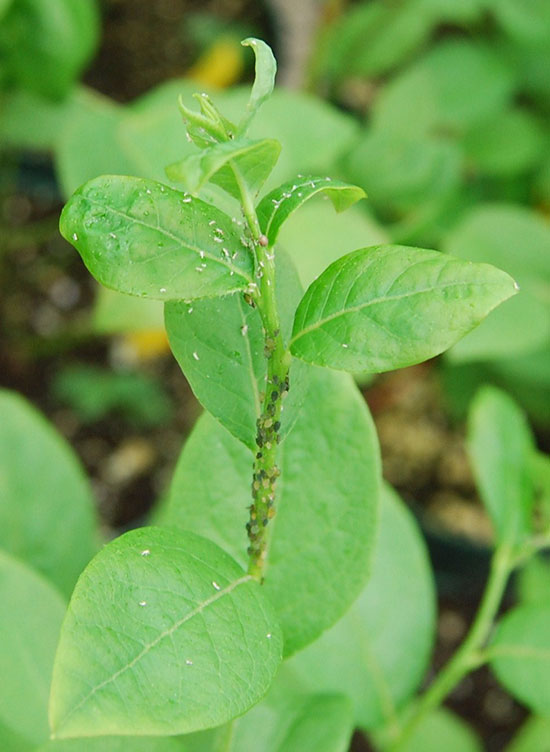
Blueberry plants are relatively free from disease, pest, and nutrient-related issues. However, one of the main concerns for blueberry growers is the aphid. It can be easily diagnosed by closely monitoring plants, using yellow sticky traps, and looking out for nymphs (young aphids), skin droppings, a glossy, sugary substance on leaf surfaces, and ants crawling on the plants. Aphids are found on actively growing blueberry shoots. Infestations can be controlled through various methods such as: a) releasing natural predators like ladybugs into the environment; b) yellow sticky traps; c) eliminating ants in the area; d) applying low concentrations of nitrogen fertilizers; or e) frequent application of high volume insecticidal soap.
 Growing Tip: Closely monitor blueberry plants to detect aphid infestation, like the one shown here.
Growing Tip: Closely monitor blueberry plants to detect aphid infestation, like the one shown here.
IRON DEFICIENCY
Interveinal chlorosis of young leaves is an indication of the unavailability of enough iron for the proper growth and development of plants. Potential causes of iron deficiency include: a high pH (above 6.8); a water table that is too high and the subsequent waterlogging; poor drainage; excessive liming; the use of basic fertilizers such as calcium nitrate; water alkalinity; and cultural practices which may affect healthy root development. Iron deficiency can be corrected by lowering the water table through draining, planting on raised beds, applying acidic fertilizers, lowering substrate pH by applying organic acids such as citric or acetic acid approved by OMRI. Application of iron sulfate will provide the required iron for blueberry plant uptake by supplying the iron while acidifying the root environment.
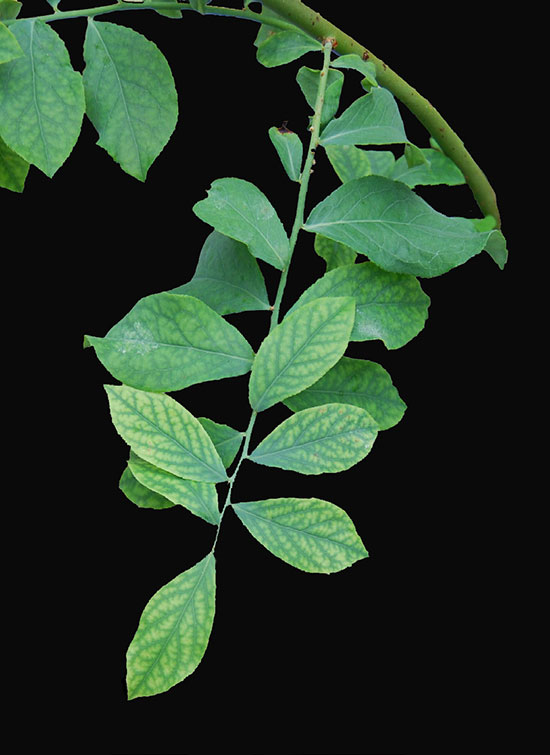
Initial iron deficiency symptoms include mild yellowing that eventually develops into distinct interveinal chlorosis in young leaves.
BORON DEFICIENCY
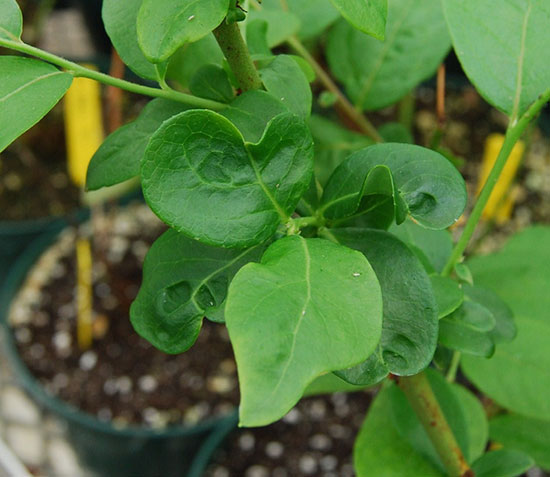
Deeper and abnormally-shaped young leaves and halted growing points are visual indications of boron deficiency.
Boron deficiency in blueberry generally develops in young leaves, which appear darker green and deformed with limited leaf expansion, twisted leaf margins, and deeply lobed surfaces (dimples formed on young leaf lamina). At this stage, the growing points stop growing, resulting in loss of apical dominance. Causes of boron deficiency include high pH (above 6.8) as a result of liming or using alkaline water for irrigation; soils or substrates low in boron (more so with soilless substrate), or use of a fertilizer that lacks boron. Lowering substrate pH to 5.0-to-5.5 is recommended for the availability of boron. Supplying boron through Borax or Solubor at a concentration of 6 ppm may help overcome this deficiency.
Growing Blueberries Downloadable pdf
More Information on Blueberries
Blueberry Nutrient Monitoring Downloadable pdf


